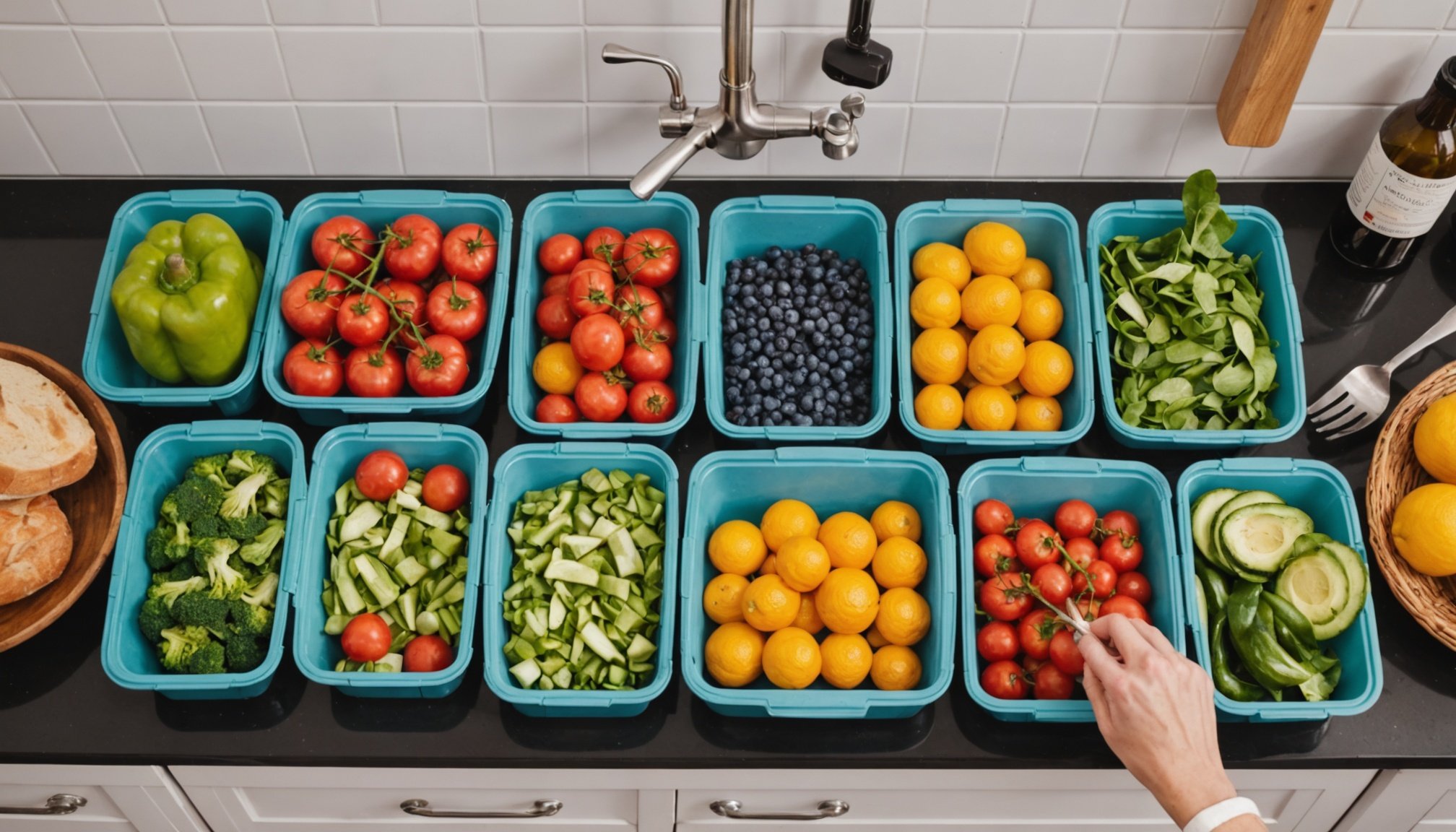Importance of Kitchen Organization in Reducing Food Waste
In today’s fast-paced world, kitchen organization plays a pivotal role in minimizing food waste. Studies reveal that a significant portion of waste arises from improper food storage, leading to spoilage. By optimizing storage and creating an organized kitchen environment, individuals can significantly impact these statistics.
An unorganized kitchen often sees perishables tucked away and forgotten until they are long past their prime. Foods stored in proper containers and at appropriate temperatures see an extended life, reducing spoilage and promoting food freshness. For example, using clear containers can drastically cut down on waste by promoting visibility, making it easier to use ingredients before they expire.
Also read : How to Design a Safe and Enjoyable Toddler Play Zone in Your Small Apartment: An Ultimate Guide
Organized kitchens also facilitate efficient meal planning and preparation, leading to less impulsive grocery shopping. When you know what’s already in your pantry or fridge, planning meals can become more straightforward. This foresight reduces food waste, as you are less likely to buy items unnecessarily.
In conclusion, an organized kitchen not only leads to better space utilization but also fosters sustainability. By prioritizing efficient storage, households can decrease their food waste, aligning themselves with a more eco-conscious lifestyle.
In parallel : Revitalize Your Creative Haven: Expert Tips for Crafting an Inspiring Scrapbooking and Fabric Arts Room
Practical Organization Hacks
Kitchen organization is not just about aesthetics—it’s a strategic tool for reducing food waste. Simple organization hacks can create a remarkable impact by leveraging efficient storage solutions. Here’s how you can transform your kitchen:
Declutter Your Pantry
By decluttering, you can gain a clear overview of the items available, reducing food spoilage. Removing expired or unwanted items leads to mindful restocking practices. Donate non-perishables that you won’t use, helping both your pantry space and the community.
Use Clear Containers for Storage
Visibility is key to minimising waste. Store food in clear containers, allowing you to see what you have, thus making it harder for items to be forgotten. This method supports food freshness by promoting frequent usage of available items, effectively reducing the chances of spoilage.
Labeling Systems for Easy Identification
Implementing a labeling system is crucial for informing every family member about what’s available. Label containers with contents and expiry dates, ensuring easy identification. This system leads to seamless meal planning and reduces the chances of purchasing duplicates. With these simple organization hacks, you’ll not only enjoy a streamlined kitchen but also contribute to significant food waste reduction.
Smart Fridge Arrangements
Organizing your fridge with refrigerator organization techniques extends food freshness and maximizes its shelf life. Here’s how to achieve an optimal setup:
FIFO Method (First In, First Out)
The FIFO (First In, First Out) method is a crucial strategy for maintaining freshness. Simply put, it involves using older items first while newer purchases are stored at the back. This method prevents older products from lingering until expiration, ensuring they’re consumed while still fresh. By regularly rotating items, you can significantly reduce spoilage and waste.
Temperature Zones in the Fridge
Understanding fridge temperature zones is essential for optimal food storage. Different sections of the refrigerator maintain varying temperatures, which are suited for specific items. For instance, the door area is often warmer and best for condiments, while the lower shelves are colder, ideal for dairy and meats. By storing food items according to these zones, you can extend their shelf life and retain their quality.
Storing Produce Safely
Properly storing produce is another consideration to prevent spoilage. Leafy greens thrive with a bit of moisture, while fruits like berries should stay dry. Utilize the crisper drawer for produce, adjusting its humidity levels to suit different items. Through safe produce storage, your groceries can maintain their freshness longer.
Meal Planning and Prepping Strategies
Incorporating effective meal planning and food preparation strategies can significantly contribute to waste minimization in the kitchen.
Weekly Meal Planning
Engaging in weekly meal planning is an excellent way to curtail impulsive purchases. By outlining meals for the week, households can ensure that their shopping list aligns with actual needs. This foresight not only prevents food from being purchased needlessly but also reduces the likelihood of it languishing unused. Meal planning also helps in managing budget effectively, as buying in bulk can lead to savings.
Batch Cooking Techniques
Batch cooking is a time-efficient strategy that also aids in reducing waste. Preparing several meals in one session ensures that ingredients are used optimally and less likely to perish. This technique provides the dual benefits of saving time throughout the week and ensuring a variety of meals without constant preparation effort.
Incorporating Leftovers Creatively
Finding creative uses for leftovers is crucial in minimizing disposal. Instead of discarding excess food, transform it into a different meal or ingredient for another recipe. For example, leftover vegetables can become a soup or stir-fry. This not only diminishes food waste but also adds excitement and variety to meals, making dining experiences more enjoyable.
Utilizing Technology for Organization
In an era of innovation, technology brings transformative solutions for kitchen organization and waste minimization. Leveraging kitchen organization apps can revolutionize how you manage ingredients. Food Inventory Apps such as Out of Milk or Yummly help maintain an accurate list of stock, ensuring you are only purchasing necessities and reducing food waste. By capturing expiry dates and organizing items, these apps allow for effective tracking.
Smart Kitchen Appliances offer another layer of efficiency and convenience. For example, smart refrigerators can remind users of expiring foods or suggest recipes based on available ingredients. This enhances food freshness and optimizes resource use, making it easier to avoid unnecessary purchases.
Online Recipe Organizers simplify meal planning by categorizing recipes and syncing them with your shopping list. Tools like Paprika or My Recipe Box allow you to save time and effort while ensuring ingredients are utilized efficiently. By adopting these technological tools, households can enjoy a streamlined approach to meal preparation, reducing food waste in the process.
Embrace these innovations and experience a smarter, more sustainable kitchen.
Real-Life Case Studies and Success Stories
In examining practical applications of kitchen organization, several inspiring success stories emerge. These real-life examples demonstrate significant food waste reduction achieved through strategic adjustments.
One household, the Johnsons, transformed their kitchen setup by incorporating clear storage bins and labeling systems. Previously plagued by forgotten perishables, they now boast a 30% decrease in waste. Their experience highlights the power of visibility and organization in sustaining freshness.
Another case involves the Thompson family, who adopted meal planning and batch cooking. By dedicating Sundays to preparing meals for the week, they eliminated impulsive buying and reduced their discarded food by half. These strategies not only saved money but also streamlined their daily schedules.
A chef turned home cook, Sarah, leveraged food inventory technology. Using apps to monitor her pantry, she crafted inventive meals, thereby cutting down on expired ingredients. Her efforts led to a 40% reduction in food waste.
Such stories exemplify how strategic organization can drive meaningful change. Kitchen organization not only enhances operational efficiency but also nurtures a more sustainable lifestyle, inspiring readers to pursue similar tactics for impactful food waste management.



